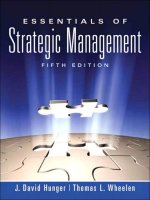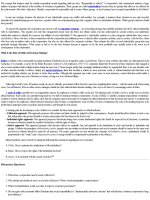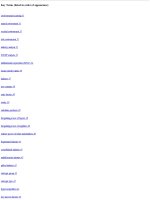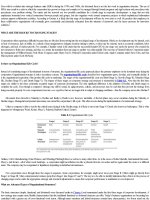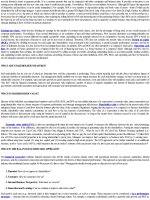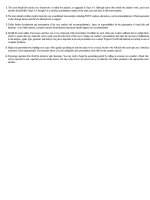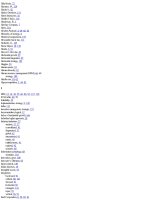Essentials of Strategic Management The Quest for Competitive Advantage_3 docx
Bạn đang xem bản rút gọn của tài liệu. Xem và tải ngay bản đầy đủ của tài liệu tại đây (284.65 KB, 26 trang )
PA R T I I
Company-Wide
ImplementationChapter 3
Company-Wide
Implementation—Overview
In Chapter 2 we talked about the two different implementation ap-
proaches contained within the Proven Path methodology: Company
Wide and Quick Slice. We’ll get into the details of Quick Slice in
Chapters 12 and 13. For now, let’s look at how to implement ERP on
a company-wide basis. To get started, consider the following:
It’s possible to swallow an elephant one chunk at a time.
Be aggressive. Make deliberate haste. Implement in about 18 months
or less.
Those two concepts may sound contradictory, but they’re not.
There’s a way to “swallow the elephant one chunk at a time” and still
get there in a reasonable time frame. Here’s the strategy:
1. Divide the total ERP implementation project into several ma-
jor phases to be done serially—one after another.
2. Within each phase, accomplish a variety of individual tasks si-
multaneously.
For almost any company, implementing all of ERP is simply too
much to handle at one time. The sum of the chunks is too much to
43
INITIAL EDUCATION AND TRAINING
SALES & OPERATIONS PLANNING
DEMAND MANAGEMENT, PLANNING, AND SCHEDULING PR
OCESSES
PROCESS DEFINITION
FINANCE & ACCOUNTING PROCESSES
PROCESS DEFINITION AND IMPLEMENTATION
SOFTWARE CONFIGURATION & INSTALLATION
PILOT AND CUTOVER
SOFTWARE SELECTION
PERFORM-
ANCE
GOALS
PROJECT
ORGANIZ-
ATION
AUDIT/
ASSESSMENT III
ONGOING EDUCATION
AND TRAINING
ADDITIONAL
INITIATIVES
BASED ON
CORPORATE
STRATEGY
ONGOING
SOFTWARE
SUPPORT
ERP PROVEN PATH
PHASE I
BASIC ERP
PHASE II
SUPPLY CHAIN
INTEGRATION
PHASE III
CORPORATE
INTEGRATION
0 1 2 3 4 5 6 7 8 9 10 11 12 13 14 15 16 17 18 1
9 +
MONTH:
GO/NO-GO
DECISION
COST/
BENEFIT
VISION
STATE-
MENT
FIRST-CUT
EDUCATION
AUDIT/
ASSESSMENT I
DATA INTEGRITY
AUDIT/
ASSESSMENT II
Figure 3-1
digest all together. That’s one reason for the multiphase approach.
Further, in many cases, activities in the subsequent phase are de-
pendent on the prior phase being completed.
The use of simultaneous tasks within each phase is based on the
need for an aggressive implementation cycle of typically one year to
18 months for a business unit of average size. Doing each of the many
tasks involved serially would simply take too long.
For the time being, let’s assume a three-phase project. Let’s exam-
ine what’s to be done in each of the three phases:
Phase I—Basic ERP:
This includes Sales & Operations Planning, demand management,
Rough-Cut Capacity Planning, master scheduling, Material Re-
quirements Planning, plant scheduling where practical, and neces-
sary applications for finance and accounting. Also included here are
the support functions of inventory accuracy, bill of material accu-
racy and structure, plus activating the feedback loops from the plant
floor and purchasing.
Basic ERP is not all of Enterprise Resource Planning. Of and by
itself, it will produce substantial results; however, key elements re-
main to be implemented. This phase normally takes about nine to
twelve months to complete.
Phase II—Supply Chain Integration:
Included here are the processes that extend ERP both backward
and forward into the supply chain: backward to the suppliers via
techniques such as supplier scheduling and Internet-based business-
to-business e-commerce; forward toward the customers via distri-
bution requirements planning and vendor managed inventories
(VMI).
1
This phase usually requires three to six months, possibly
more depending on the scope and intensity of the applications.
Company-Wide Implementation—Overview 45
1
Many people use the term VMI to refer to linking with their suppliers and refer
to customer linking as Continuous Replenishment (CR). With either term, the pro-
cesses are the same.
Phase III—Extensions and Enhancements to Support Corporate
Strategy:
This phase covers the extension of ERP software capabilities fur-
ther throughout the total organization. It can include completion of
any finance and accounting elements not yet implemented, linkages
to other business units within the global organization, HR applica-
tions, maintenance, product development, and so on.
Also included here may be enhancements that were identified ear-
lier as desirable but not absolutely necessary for phases I or II to be-
come operational. This could include full simulation capabilities,
advanced planning systems (APS), manufacturing execution sys-
tems (MES), enhanced customer order entry processes, develop-
ment of a supplier rating system, and so forth.
Time required for phase III could range from several months to
more than a year, reflecting the fact that this phase is less defined and
more “free form” than the prior two phases. In fact, there’s a pro-
gression here: phase I is somewhat more structured than phase II,
and phase II more so than phase III.
Let’s consider elapsed time for a moment. From the above, we
can see that phase I (Basic ERP) begins at time zero and contin-
ues through months 9 to 12, phase II (Supply Chain Integration)
through months 12 to 18, and phase III (Extensions and Enhance-
ments) through about months 18 to 30.
This says that the total project’s time can range from a bit more
than a year up to between two and three years. Why the broad time
span? It’s mainly a function of several things; one factor is the size
and complexity of the organization, another of course, is the re-
sources, and perhaps the most important element is the scope of the
overall project, that is, how extensively the supply chain tools are to
be deployed and how far extensions and enhancements will be pur-
sued.
Here’s the critical point regarding timing: Implementing Basic
ERP successfully (the phase I task) will generate enormous benefits
for the company. And, if you do it right, you can get it done in nine to
twelve months. Part of doing it right is to avoid “scope creep,” i.e.,
laying non-critical tasks into phase I. It’s necessary here to adopt a
hard-nosed attitude that says: “We’re not going to tackle anything in
phase I that’s not necessary for Basic ERP. When we come across
46 ERP: M I H
‘nice-to’s’ (opportunities that aren’t essential for Basic ERP), we’ll
slot them into phase II or III. All we’ll work on during phase I are the
‘have-to’s’—stuff that’s essential for Basic ERP.”
On occasion, people question the location of time zero—the day
the clock starts ticking. Should it follow the early and preliminary
steps, as shown on the phase I bar chart? Or should it be at the very
beginning of audit/assessment I?
We prefer it where it is, because that facilitates the consensus
building, which is so important. Some companies move through
these early steps quickly, so for them the precise location of time zero
is not terribly important. Other companies, however, find they need
more time for these early activities than the several months implied
by the chart. The principles to be considered are:
1. Take as much time as needed to learn about ERP, and build a
consensus among the management team. Set the vision state-
ment and the performance goals. Do the cost/benefit analysis.
Make sure this is the direction the company wants to go. Then
commit to the project.
2. Once the decision is made to go for it, pursue it aggressively.
Occasionally, people have questions on the functional content of
each of the three phases, such as: “Why isn’t supplier scheduling in
phase I? Can we move MRP to phase II and Sales & Operations
Planning to phase III?”
The timing of this implementation plan is structured to get the ba-
sic ERP planning tools in place early. For example, companies that
implement advanced supplier scheduling—possibly via the Inter-
net—before material requirements planning, may save a few bucks
on reduced paperwork and get a better handle on order status, but
probably not much else.
This is because most companies, prior to successful ERP, can’t
give their suppliers good schedules. The reason is their current sys-
tems can’t generate and maintain valid order due dates as conditions
change. (These companies schedule their suppliers via the shortage
list, which is almost always wrong, contradictory, and/or incom-
plete.) The biggest benefit from effective supplier scheduling comes
from its ability to give the suppliers valid and complete schedules—
Company-Wide Implementation—Overview 47
statements of what’s really needed and when. It simply can’t do that
without valid order due dates, which come from Material Require-
ments Planning (MRP).
Further, material requirements planning can’t do its job without a
valid master schedule, which must be in balance with the sales & op-
erations plan. That’s why these functions are in phase I, and certain
“downstream” functions are in phase II.
S
CHEDULE BY
F
UNCTION
,N
OT
S
OFTWARE
M
ODULES
Business functions and software modules are not the same. A busi-
ness function is just that—something that needs to be done to run the
business effectively. Examples include planning for future capacity
needs; maintaining accurate inventory records, bills of material, and
routings; customer order entry and delivery promising; and so on.
Software modules are pieces of computer software that support
people in the effective execution of business functions. Frequently
we see companies involved in an ERP implementation scheduling
their project around tasks like: “Implement the SOE (Sales Order
Entry) module,” “Implement the ITP (Inventory Transaction Pro-
cessing) module,” or “Implement the PDC (Product Data Control)
module.” This is a misguided approach for two reasons: sequence
and message.
Companies that build their project plan around implementing
software modules often do so based on their software vendor’s rec-
ommendation. This sequence may or may not be the best one to fol-
low. In some cases, it merely slows down the project, which is serious
enough. In others, it can greatly reduce the odds for success.
One such plan recommended the company first install the MRP
module, then the plant floor control module, then the master sched-
uling module. Well, that’s backward. MRP can’t work properly with-
out the master schedule, and plant floor control can’t work properly
without MRP working properly. To follow such a plan would have
not only slowed down the project but also would have substantially
decreased the odds for success.
The second problem concerns the message that’s sent out when the
implementation effort is focused on software modules. Concentrat-
ing on implementing software modules sends exactly the wrong mes-
sage to the people in the company. The primary emphasis is on the
48 ERP: M I H
TEAMFLY
Team-Fly
®
wrong thing—the computer. ERP is not a computer system; it’s a
people system made possible by the computer. Implementing it is not
a computer project or a systems project; it’s a management project.
The people in the company are changing the way they manage the
business, so that they can manage it better than they ever could
before.
Keep those ABC’s of implementation firmly in mind: the C item is
the computer; the B item is the data; the A item is the people.
C
UT THE
C
LOTH TO
F
IT THE
P
ATTERN
ERP is a generalized set of tools that applies to any manufacturing
company. Part of the A-item implementation task is to help people
break through the “we’re-unique” syndrome that we talked about
earlier. When people recognize that there is a well-defined, univer-
sally applicable body of knowledge in this field, they’ll be able to use
it to solve fundamental problems.
On the other hand, ERP is a set of tools that must be tailored to fit
individual companies. The implementation project must also reflect
the individual company, its environment, its people, its processes, its
history, and so on. Here are some examples of special situations that
can affect the specifics of implementation:
Flow shops.
Flow shop is the term we give companies with manufacturing
methods that can be described as purely process (chemicals, food,
plastics, etc.) or as highly repetitive (tin cans, automobiles, razor
blades, etc.).
The overall concept of ERP definitely applies to these kinds of
manufacturing environments. However, each and every function
within ERP may not be necessary. One good example is shop floor
dispatching on an operation-by-operation basis, which is typically
needed only in a functional, job-shop form of organization.
2
The
technique known as detailed Capacity Requirements Planning
(CRP) is another. In most flow shops, all of the necessary capacity
Company-Wide Implementation—Overview 49
2
For an explanation of the job shop/flow shop differences, see Appendix B.
planning can be done at the rough-cut level. Simple output tracking
can be used instead of the more complex input-output control.
A company in this situation, not needing detailed shop dispatch-
ing and CRP, should exclude them from its implementation plan.
Simple plant schedules (plant sequence lists, not shop dispatch lists)
can usually be generated directly from the master schedule or Ma-
terial Requirements Planning as a part of phase 1. And that’s good
news. It’ll be easier and quicker to get to Class A.
Financials already integrated.
Some companies, prior to implementing ERP, already use opera-
tional data to drive much of their financial reporting. Numbers from
the operating system are converted to dollars for certain financial
planning and control purposes; product costing and inventory valu-
ation are two functions often already integrated. At a minimum, of
course, the current degree of financial integration must be imple-
mented as part of phase I, not phase III.
Companies with high degrees of financial integration, prior to
ERP, are often seen in the process world (i.e., flow shops). For many
of these companies, virtually all of their financial system implemen-
tation will occur in phase 1.
Re-implementers.
Some companies have already attempted to implement ERP, but
it’s not working properly. They have some or all of the pieces in place,
yet they’re not getting the results they should. Now they need to re-
implement, but this time to do it right. Darryl Landvater said it well:
“The jobs involved in improving an (ERP) system are the same as
those in implementing it correctly.” As we said earlier, the difference
is that, for re-implementers, some of the tasks may already be done.
That’s perhaps the good news. However, in a re-implementation,
there’s one big issue that makes it tougher: how to convince all the
people that it’ll work the second time around
3
when it didn’t work
50 ERP: M I H
3
Or third possibly? We’ve talked to people whose companies were in their third
or fourth implementation. This gets really tough. The best number of times to im-
plement ERP is once. Do it right the first time.
well after the first try. This will put more pressure on the education
process, which we’ll discuss later, and on top management’s actions.
Words alone won’t do it. Their feet and their mouths must be mov-
ing in the same direction.
ES/No ERP.
Here are the many companies that have installed Enterprise Soft-
ware but not done much about improving business processes. In
most respects, they’re quite similar to re-implementers: Some of the
implementation tasks have been done—mostly software-related—
so those steps can largely be dropped from their plans.
Multiplant.
How about a company or division with more than one plant? How
should it approach implementation? Broadly, there are three choices:
serial, simultaneous, or staggered.
Take the case of the Jones Company, with four plants. Each plant
employs hundreds of people, and has a reasonably complete support
staff. The company wants to implement ERP in all four plants.
The serial approach to implementation calls for implementing
completely in a given plant, then starting in the second plant and im-
plementing completely there, and so forth. The schedule would look
like Figure 3-2:
This time span is not acceptable. Sixty months is five years, and
that’s much too long.
The simultaneous approach is to do them all at the same time, as
shown in Figure 3-3.
Company-Wide Implementation—Overview 51
Plant 1 Plant 2 Plant 3 Plant 4
Month 0 15 30 45 60
Figure 3-2
Serial Approach
This approach looks good because the entire project is finished in 15
months. However, there may be some problems. One would be avail-
ability of centralized resources such as Information Systems, overall
project management, and so forth. It may be impractical to support
all four plants simultaneously.
Another potential problem gets back to the catch-22 of ERP. Im-
plementing ERP is not the first priority. Some companies may wisely
conclude that implementing simultaneously in all plants could be
more than they want to bite off at one time. The effort and intensity
required may be more than desired.
This leads most companies to choose the staggered method shown
in Figure 3-4.
This approach has several advantages
1. ERP gets implemented throughout the entire company fairly
quickly (in this case, in slightly over two years for four plants).
2. The impact on centralized resources is lessened.
3. Only one plant is piloting and cutting over onto master sched-
uling (MS) and Material Requirements Planning (MRP) at a
time, so the overall level of effort and intensity is reduced.
4. Plant personnel can teach each other. For example, users from
52 ERP: M I H
Figure 3-3
Simultaneous Approach
Plant 1
Plant 2
Plant 3
Plant 4
Month 0 15
plant 2 may participate in the pilot and cutover at plant 1. In so
doing, they can learn from the first plant’s mistakes and avoid
them. Plant 3 people can learn and help at plant 2, and so on.
One company we worked with brought all nine of its plants from
time zero to Class A in less than three years. This was a very complex
implementation, and the staggered method served them very well.
Please note: Even though their implementation was staggered, Sales
& Operations Planning was implemented across the board and was
done early. The reasons:
1. S&OP only really works well when it operates across the en-
tire business unit.
2. Implementing S&OP does not typically involve major re-
sources.
3. In a combined ERP/ES implementation, S&OP can be imple-
mented independently of software considerations. It doesn’t
need to “wait for the software.”
4. It’s an early win.
Company-Wide Implementation—Overview 53
Figure 3-4
Staggered Approach
Plant 1
Plant 2
Plant 3
Plant 4
15
18
21
24
Month 0
15 18 21 24
We recommend you follow this company’s example, and implement
S&OP across the board—early.
Multiple business units.
Many organizations have more than one business unit. These
could be corporations with multiple divisions, or perhaps divisions
containing more than one business. The Acme Widget company, for
example, is a stand-alone corporation with three divisions: indus-
trial, consumer, and aerospace and defense. Each division is self-
contained and has its own plant.
If centralized, corporate resources will be involved in the ERP im-
plementation, then Acme should follow the approach outlined above
in the multiplant section. On the other hand, if Acme’s divisions are
highly self-contained with ample resources, then there may be no
need for Corporate to force fit the divisions into a centralized imple-
mentation schedule. They may feel more accountability, and imple-
ment faster, if they’re calling the shots on their schedule.
Obviously, it doesn’t matter if Acme Widget were a stand-alone
corporation or, alternatively, part of a larger corporation. The ap-
proach we’ve outlined here would apply in either case.
Necessary nonstandard functions.
Here, we’re referring to functions necessary to run the business,
but which are peculiar to a given company or industry. Some ex-
amples are:
1. The pharmaceutical industry, among many others, requires
lot traceability and lot number inventory control.
2. Firms supplying the U.S. Department of Defense must adhere
to special contract accounting requirements.
3. Product shelf life is a major issue in many companies produc-
ing consumer packaged goods.
There are many other examples. The message here is obvious:
Look very closely at the company, its industry and marketplace, its
position within them, and its overall strategy. Don’t make the serious
54 ERP: M I H
error of assuming that if a given function isn’t in the software pack-
age, it’s not needed for your company. The new software may need to
be modified to support the function in question, ideally enabling it to
be done even better. Perhaps the software will need modification
merely to allow the function to be done as before. Or perhaps no soft-
ware changes will be necessary for a given function.
It’s important for companies to do their homework on such issues.
They need to ask: “What special things are we doing today that we’ll
continue to do in the future after ERP is operational? Are they es-
sential? If so, will they be handled within ERP or not? If not, how will
we do them?”
Part of getting a better set of tools to run the business is to make
certain that all of the necessary tools are in place.
T
IME
W
ASTERS
Nowhere on the Proven Path does one see things like:
• Document the current system in detail.
• Design the new system.
That’s because these things are time wasters when done as separate
activities.
Yes, it is necessary to identify those elements of today’s operations
that need to be blended into ERP. What’s not necessary is to spend
time doing a detailed documentation of the current system, with
piles of paper and flow charts covering many square yards of wall
space. After all, the current system is going to be replaced.
And, yes, it’s necessary to ensure that the details of how ERP will
be operated support the company’s goals, operating environment,
and necessary functions. What’s not necessary is to spend time re-
inventing the wheel. The set of tools is already designed; it’s called
ERP. The issue is how, specifically and in detail, will the tools of ERP
be used to run the business?
The Proven Path approach makes provisions for these things, to
occur not as separate steps, but as part of an integrated, logical pro-
cess of managing the implementation of ERP. The details will come
in Chapters 5, 6, and 7.
Company-Wide Implementation—Overview 55
56 ERP: M I H
Q & A
WITH THE
A
UTHORS
M
IKE
: Might some people have a problem with what we just
said—the system is already designed; it’s called ERP; and that the
issue is how will the tools of ERP be used to run the business?
T
OM
: Probably, and to help with that, let’s once again hop over
into the wonderful world of accounting. When a company gets
ready to implement a new accounting system, they don’t sit down
and design a new approach to accounting. They don’t re-invent
double-entry bookkeeping and GAAP. They recognize that there
exists a defined body of knowledge in this field, and that their
challenge is to utilize that body of knowledge in the best way pos-
sible.
ERP, as we said earlier, is the logistics analog of GAAP and its
basic structure should be considered as a given. The focus needs
to be on how to use the tools within ERP in the best way possible.
Chapter 4
Software
Back in Chapter 1, we talked about how software for ERP is like a set
of golf clubs. We said that owning a fine set of clubs does not by it-
self make a good golfer. On the other hand, playing golf at a world-
class, competitive level requires a full set of clubs, even if your name
happens to be Tiger Woods. The same is true for companies: Owning
good software of and by itself won’t make you more competitive, but
to be competitive requires a reasonably complete set of software.
The emergence of Enterprise Software over the past ten years has
revolutionized not just how computers are used but the very way
companies think. In the past, a typical company would design its
own software for individual operations or would purchase “off the
shelf” software for specific tasks. This led to a complex mix of non-
matching systems that rarely communicated well and led to extensive
maintenance of systems. Companies had large IS (information sys-
tems) or IT (information technology) organizations that wrote soft-
ware, provided the linkages to purchased systems, and maintained
the system. Because these software experts were often located inside
individual business units, it sometimes happened that different units
could not communicate with each other except through written
reports.
The development of the Enterprise Software systems offered the
clear advantage of connecting every transaction in the company to a
central database that could be accessed by the appropriate corporate
systems. Unloading a truckload of chemicals in any part of the com-
57
INITIAL EDUCATION AND TRAINING
SALES & OPERATIONS PLANNING
DEMAND MANAGEMENT, PLANNING, AND SCHEDULING PR
OCESSES
PROCESS DEFINITION
FINANCE & ACCOUNTING PROCESSES
PROCESS DEFINITION AND IMPLEMENTATION
SOFTWARE CONFIGURATION & INSTALLATION
PILOT AND CUTOVER
SOFTWARE SELECTION
PERFORM-
ANCE
GOALS
PROJECT
ORGANIZ-
ATION
AUDIT /
ASSESSMENT III
ONGOING EDUCATION
AND TRAINING
ADDITIONAL
INITIATIVES
BASED ON
CORPORATE
STRATEGY
ONGOING
SOFTWARE
SUPPORT
ERP PROVEN PATH
PHASE I
BASIC ERP
PHASE II
SUPPLY CHAIN
INTEGRATION
PHASE III
CORPORATE
INTEGRATION
0 1 2 3 4 5 6 7 8 9 10 11 12 13 14 15 16 17 18 19
+
MONTH:
GO/NO-GO
DECISION
COST/
BENEFIT
VISION
STATE-
MENT
FIRST-CUT
EDUCATION
AUDIT/
ASSESSMENT I
DATA INTEGRITY
AUDIT/
ASSESSMENT II
Figure 4-1
TEAMFLY
Team-Fly
®
pany became a corporate piece of data, not just an isolated act to be
observed only locally. This also means that the company financial
books can be adjusted for the cost of this transaction immediately.
There is no delay for passing data from point to point or clerk to
clerk. This is good stuff; it offers enormous benefits.
What has happened here is that companies are moving from a
wide variety of relatively simple systems but with complex interfaces,
to a single complex system with simple interfaces. This clear choice
offers major benefits to the corporation but is seen as painful by each
unit of the company. For most, this is the proper trade-off. However,
the choice does have a major impact.
We said in Chapter 1 that this is not a software book. Then why in-
clude this chapter on software? Simply because every manufacturing
company needs ERP and there are big decisions to be made about
software interactions. A company implementing ERP will be in one
of three categories regarding software:
The Enterprise System software (ES) has already been installed.
Now the company wants to improve its business processes by im-
plementing ERP.
The company plans to install an ES simultaneously with implement-
ing ERP.
The company has no ES and presently has no plans to install one. It
wants to implement ERP, perhaps using a legacy system or possi-
bly by acquiring low-cost software to support the core ERP func-
tions of demand management, master scheduling, Material
Requirements Planning, and so on.
We’ll look at each one of these conditions individually and then,
towards the end of this chapter, we’ll discuss the issue of “bolt-ons.”
This is software from outside the ES, which performs certain specific
functions.
C
ATEGORY
1: ES A
LREADY
I
NSTALLED
The typical company in this category has, with substantial pain and
expense, installed an Enterprise System and not gotten much back in
return for its efforts. The ES enabled it to become Y2K compliant and
Software 59
it can close the books better, faster and cheaper than before—but that
may be about it in terms of benefits. Many companies think they are
ES capable simply because they survived Y2K. Of course, they may
have only installed some of the ES modules and may be limping along
with mediocre results. The people are a bit bummed and a bit burned
out; they spent endless hours sitting in meetings and in training ses-
sions but they find that things haven’t gotten any easier.
The good news is that having the software already installed cer-
tainly makes life easier in some important respects. First, the soft-
ware selection step shown in Figure 4-1 can pretty much be dropped.
The bulk of the software has already been selected, with the possible
exception of one or several bolt-ons.
Second, the software installation and enhancement step on the
Proven Path should be straightforward. Most of the work here will
involve nothing more than re-setting some of the switches in the ES,
to enable the core ERP functions to operate correctly. During this
step, it’s important to involve people with a good knowledge of the
ES in order to help identify and facilitate this process of “tweaking”
the system.
A caveat: This requires real expertise and great care. Remember
that the linkages in ES are so extensive that even a minor change in-
volving a few switches can have far-reaching effects. In Chapter 7,
which deals with education, we’ll discuss a process involving a series
of business meetings; these can be an important forum for identify-
ing necessary changes to the ES configuration.
One last point: Companies that have already installed an ES are
strong candidates for a Quick-Slice ERP implementation. See Chap-
ters 13 and 14.
C
ATEGORY
2: I
NSTALLING
ES S
IMULTANEOUSLY WITH
ERP
Frequently companies in this category do so because of an interest in
ERP. They want to do ERP; they know they need software to do that,
so they go out and buy an ES. Unfortunately, companies attempting
this almost always get overwhelmed by the complexity and magni-
tude of the software. The result: The software gets installed but the
ERP business processes are not implemented well or at all; the com-
pany is at a Class D level or maybe Class C if they got lucky.
The sad fact is that very few companies have successfully imple-
60 ERP: M I H
mented both ERP and an ES at the same time. It’s just too big a job.
Therefore, we offer the following warning:
Before you attempt a combined ERP/ES implementation, evaluate
your resources very carefully. Make certain that you are one of the
few companies that have enough resources and organizational band-
width to get the job done successfully. If you conclude otherwise,
then your best route is probably to implement ERP first and then ES.
Figure 4-2 shows the high level of decision involved in this overall
software issue.
If you decide that you can succeed with a combined ERP/ES im-
plementation, then the section that follows applies to you. (It may
also be of interest to companies that decide to install their ES prior
to ERP.) An excellent source of information on installing ES soft-
ware is the book we mentioned in the first chapter: Mission Critical
i
by Thomas H. Davenport. When installing an Enterprise System,
you’ll need all the good information you can get.
Let’s be clear on the ERP/ES implementation concept. It is clearly
the most efficient way to handle these two major changes. However,
very few companies can provide the resources to pull it off. The re-
source drain is huge and hiring armies of outsiders to help is not the
answer. Most who have tried to do both have stopped in mid-project
and done one or the other. Typically, the nature of the ES installation
requires that the company finish ES and then get back to ERP later.
Danger lurks among the rewards!
Threatening? You bet. Chapter 5 will deal with the costs and ben-
efits of the total ERP/ES implementation more completely but, for
now, remember that the choice and installation of the software re-
quires the same careful planning as any other project that costs mil-
lions of dollars and involves almost every person in the company.
C
ATEGORY
3: N
O
ES
AND
N
O
P
LANS TO
G
ET
O
NE
The typical company here has neither ERP nor an Enterprise Soft-
ware system. It wants to implement ERP but is not interested in
going through the blood, sweat, tears, and expense of an ES installa-
tion. Regarding software for its ERP implementation, it either has it
or it doesn’t. (Hard to argue with that, right?)
Software 61
Do you want
to implement
ERP?
Do you have
Enterprise Soft-
ware (ES)?
Do you want to
install in ES?
Do you
have resources
for both ERP
and ES?
Implement ERP
and ES
simultaneously
Implement ERP
only
(ES maybe later)
Implement ERP
using ES
N
N
N
N
Y
Y
Y
Y
Figure 4-2
Implementing ERP
In the first case, “having it” usually means that it has an older, pre-
ES set of software for MRP II. Perhaps the company took an earlier
stab at implementing the resource planning processes—master
scheduling, MRP, Plant and Supplier Scheduling, etc.—but didn’t
succeed. Or possibly it never attempted to do so. In either case, it has
software. Now the people might not like it; they might be saying
things like, “Our software stinks.” But the odds are quite high that
it’ll be good enough to enable the basic ERP processes to work. The
moral of this story: use what you have if it’s workable. An excellent
resource here is the MRP II Standard System, which details the fea-
tures and functions that software must contain to support effective
resource planning processes. As of this writing, this document is
available via the Gray Research web site listed in Appendix D.
The second case states that the company doesn’t have software to
support ERP. Perhaps its legacy systems are home grown, and they
contain logic that simply won’t work in an ERP environment. In this
case, we recommend you buy one of the many low-cost PC-based
ERP/MRP II packages that are available today. You can probably get
everything you need for less than $100,000. And most of it is quite
good—fairly complete functionally and very user friendly. Since the
price is relatively low, you can buy it and use it for a year or so, and
then if need be, replace it with a full-blown set of ES software if you
wish to head in that direction. Please keep in mind that this ERP/
MRP II software is not an ES; it won’t be truly stand-alone software;
and it will in effect be “bolted-on” to your existing software.
E
NTERPRISE
S
OFTWARE
Now that we have talked about the choices, it is time to discuss a bit
more about Enterprise Software. We’ll take you through our
thoughts on ES in four steps: Selection, Configuration and Enhance-
ment, Installation, and Ongoing Support.
The Selection step is the beginning of the project when the com-
pany must decide which software company will best handle the in-
formation transactions for its business.
Configuration and enhancement are handled by design teams.
These are the internal teams that make sure that the right switches
are thrown for each decision process and identify needed enhance-
ments and extensions.
Software 63
Installation is probably the most obvious step since whatever is
chosen must be put in place. The opportunities and challenges are
in maximizing learning during implementation and minimizing
crashes.
Ongoing support refers to the maintenance and improvement of
the system after start-up. Those who have looked at the ES initiative
as a one-time project with no follow-up care and feeding have been
very disappointed.
Software Selection
There are lots of software choices available. The key point here is that
there is not a single right software choice. There are good choices and
not so good choices for your business.
OK, how to proceed? First, understand your business and the op-
portunities for change. Yeah, this sounds insulting. Of course, you
know your business. But do you know where the real weaknesses are
in the business? Are you having trouble with delivery timeliness and
accuracy for your customers? Are cost projections erratic and unre-
liable? Do customer orders “get lost” inside the system, requiring
massive human intervention? Does the supplier interaction become
so complex that the supply chain resembles a pretzel? Are human re-
source systems clogged with massive data that cannot be assessed to
answer basic employee demographic questions?
Understanding these and other questions will tell you what areas
are of most importance to you in choosing a software provider. Each
of these questions impacts a different software module and each soft-
ware provider offers different approaches to those areas. Without this
knowledge of the company’s strategic and tactical needs, you’re sub-
jected to sales presentations by the software vendors without knowing
which areas of the pitch are most important. You need to know that
the vendor you choose has solid offerings in the areas where you have
the most need. A good question to ask is this: “If we have software
from this provider, can we make a competitive breakthrough?” This
question and its answer will typically point you to the ERP related
modules that deal with demand management, master scheduling,
MRP, plant and supplier scheduling, warehouse management, etc.
Also, you need to consider which vendor’s approach best matches
your present environment. Invite them to an extensive tour of your
64 ERP: M I H

